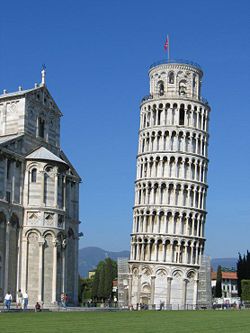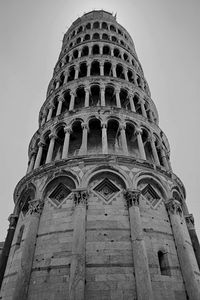Leaning Tower of Pisa
2008/9 Schools Wikipedia Selection. Related subjects: Architecture
| Leaning Tower of Pisa | |
 |
|
| Basic information | |
|---|---|
| Geographic coordinates | |
| Religious affiliation | Roman Catholic |
| Province | Pisa |
| District | Pisa |
| Specifications | |
| Height (max) | 55.86 metres (183.3 ft) |
| Materials | White marble |
The Leaning Tower of Pisa ( Italian: Torre pendente di Pisa) or simply The Tower of Pisa (La Torre di Pisa) is the campanile, or freestanding bell tower, of the cathedral of the Italian city of Pisa. It is situated behind the Cathedral and it is the third structure by time in Pisa's Piazza del Duomo (Cathedral Square).
Although intended to stand vertically, the tower began leaning to the southeast soon after the onset of construction in 1173 due to a poorly laid foundation and loose substrate that has allowed the foundation to shift direction. The tower presently leans to the southwest.
The height of the tower is 55.86 m (183.27 ft) from the ground on the lowest side and 56.70 m (186.02 ft) on the highest side. The width of the walls at the base is 4.09 m (13.42 ft) and at the top 2.48 m (8.14 ft). Its weight is estimated at 14,500 tonnes. The tower has 296 or 294 steps; the seventh floor has two fewer steps on the north-facing staircase. The tower leans at an angle of 3.97 degrees. This means that the top of the tower is 3.9 meters from where it would stand if the tower were perfectly vertical.
Construction
The Tower of Pisa was a work of art, performed in three stages over a period of about 177 years. Construction of the first floor of the white marble campanile began on August 9, 1173, a period of military success and prosperity. This first floor is surrounded by pillars with classical capitals, leaning against blind arches.
The tower began to sink after construction progressed to the third floor in 1178. This was due to a mere three-meter foundation, set in weak, unstable subsoil. This means the design was flawed from the beginning. Construction was subsequently halted for almost a century, because the Pisans were almost continually engaged in battles with Genoa, Lucca and Florence. This allowed time for the underlying soil to settle. Otherwise, the tower would almost certainly have toppled. In 1198, clocks were temporarily installed on the third floor of the unfinished construction.
In 1272, construction resumed under Giovanni di Simone, architect of the Camposanto. In an effort to compensate for the tilt, the engineers built higher floors with one side taller than the other. This made the tower begin to lean in the other direction. Because of this, the tower is actually curved. Construction was halted again in 1284, when the Pisans were defeated by the Genoans in the Battle of Meloria.
The seventh floor was completed in 1319. The bell-chamber was not finally added until 1372. It was built by Tommaso di Andrea Pisano, who succeeded in harmonizing the Gothic elements of the bell-chamber with the Romanesque style of the tower. There are seven bells, one for each note of the musical scale. The largest one was installed in 1655.
After a phase (1990-2001) of structural strengthening, the tower is currently undergoing gradual surface restoration, in order to repair visual damage, mostly corrosion and blackening. These are particularly strong due to the tower's age and to its particular conditions with respect to wind and rain.
The architect
There has been controversy about the real identity of the architect of the Leaning Tower of Pisa. For many years, the design was attributed to Guglielmo and Bonanno Pisano , a well-known 12th-century resident artist of Pisa, famous for his bronze casting, particularly in the Pisa Duomo. Bonanno Pisano left Pisa in 1185 for Monreale, Sicily, only to come back and die in his home town. His sarcophagus was discovered at the foot of the tower in 1820. However recent studies seem to indicate Diotisalvi as the original architect due to the time of construction and affinity with other Diotisalvi works, notably the bell tower of San Nicola (Pisa) and the Baptistery in Pisa. However, he usually signed his works and there is no signature by him in the bell tower which leads to further speculation.
History
Galileo Galilei is said to have dropped two cannon balls of different masses from the tower to demonstrate that their descending speed was independent of their mass. This is considered an apocryphal tale, and the only source for it comes from Galileo's secretary.
In 1934 Benito Mussolini ordered that the tower be returned to a vertical position, so concrete was poured into its foundation. However, the result was that the tower actually sank further into the soil.
During World War II, the Allies discovered that the Nazis were using it as an observation post. A U.S. Army sergeant was briefly entrusted with the fate of the tower. His decision not to call in an artillery strike saved the edifice.
On February 27, 1964, the government of Italy requested aid in preventing the tower from toppling. It was, however, considered important to retain the current tilt, due to the vital role that this element played in promoting the tourism industry of Pisa. A multinational task force of engineers, mathematicians and historians was assigned and met on the Azores islands to discuss stabilization methods. It was found that the tilt was increasing due to the stonework expanding and contracting each day due to the heat of sunlight. This was working in combination with the softer foundations on the lower side. Many methods were proposed to stabilize the tower, including the addition of 800 metric tons of lead counterweights to the raised end of the base.
On 7 January 1990, after over two decades of work on the subject, the tower was closed to the public. While the tower was closed, the bells were removed to relieve some weight, and cables were cinched around the third level and anchored several hundred meters away. Apartments and houses in the path of the tower were vacated for safety. The final solution to prevent the collapse of the tower was to slightly straighten the tower to a safer angle, by removing 38 m3 of soil from underneath the raised end. The tower was straightened by 18 inches (45 centimetres), returning to the exact position that it occupied in 1838. After a decade of corrective reconstruction and stabilization efforts, the tower was reopened to the public on December 15, 2001, and has been declared stable for at least another 300 years.
In 1987, the tower was declared as part of the Piazza dei Miracoli UNESCO World Heritage Site along with neighbouring cathedral, baptistery and cemetery.
In May 2008, after the removal of another 70 tonnes of earth, engineers announced that the Tower had been stabilized such that it had stopped moving for the first time in its history. They stated it would be stable for at least 200 years.
Certain information and suppositions
The following data are helpful in establishing the credibility of the history line of the Leaning Tower of Pisa :
- On 5 January 1172, Donna Berta di Bernardo, a widow and resident of the house of dell'Opera di Santa Maria, bequeathed sessanta soldi or "sixty coins" to the Opera Campanilis petrarum Sancte Marie. This money was to be used toward the purchase of a few stones which still form the base of the bell tower today.
- On 9 August 1173, the foundations of the Tower were laid.
- Nearly four centuries later Giorgio Vasari wrote : "Guglielmo, according to what is being said, in [this] year 1174 with Bonanno as sculptor, laid the foundations of the belltower of the cathedral in Pisa."
- Another possible builder is Gerardo di Gerardo. His name appears as a witness to the above legacy of Berta di Bernardo as "Master Gerardo", and as a worker whose name was Gerardo.
- A more probable builder is Diotisalvi, because of the construction period and the structure's affinities with other buildings in Pisa. But he usually signed his works, and there is no signature by him in the belltower.
- Giovanni di Simone was heavily involved in the work of completing the tower, under the direction of Giovanni Pisano, who at the time was master builder of the Opera di Santa Maria Maggiore. He could be the same Giovanni Pisano who completed the belfry tower.
- Giorgio Vasari indicates that Tommaso di Andrea Pisano was the designer of the belfry between 1360 and 1370.
- On 27 December 1233 the worker Benenato, son of Gerardo Bottici, oversaw the continuation of the construction of the belltower.
- On 23 February 1260 Guido Speziale, son of Giovanni, a worker on the cathedral Santa Maria Maggiore, was elected to oversee the building of the Tower.
- On 12 April 1264 the master builder Giovanni di Simone and 23 workers went to the mountains close to Pisa to cut marble. The cut stones were given to Rainaldo Speziale, worker of St. Francesco.
Technical information
- Elevation of Piazza dei Miracoli: about 2 metres (6 feet, DMS)
- Height: 55.863 metres (183 ft 3 in), 8 stories
- Outer diameter of base: 15.484 m
- Inner diameter of base: 7.368 m
- Angle of slant: 3.97 degrees or 3.9 m from the vertical
- Weight: 14,700 tonnes
- Thickness of walls at the base: 8 ft (2.4 m)
- Total number of bells: 7, tuned to musical scale, clockwise
- 1st bell: L'assunta, cast in 1654 by Giovanni Pietro Orlandi, weight 3,620 kg (7,981 lb)
- 2nd bell: Il Crocifisso, cast in 1572 by Vincenzo Possenti, weight 2,462 kg (5,428 lb)
- 3rd bell: San Ranieri, cast in 1719- 1721 by Giovanni Andrea Moreni, weight 1,448 kg (3,192 lb)
- 4th bell: La Terza (1st small one), cast in 1473, weight 300 kg (661 lb)
- 5th bell: La Pasquereccia or La Giustizia, cast in 1262 by Lotteringo, weight 1,014 kg (2,235 lb)
- 6th bell: Il Vespruccio (2nd small one), cast in the 14th century and again in 1501 by Nicola di Jacopo, weight 1,000 kg (2,205 lb)
- 7th bell: Dal Pozzo, cast in 1606 and again in 2004, weight 652 kg (1,437 lb)
- Steps to bell tower: 296
A special note on the 5th bell: The name Pasquareccia comes from Easter, because it used to ring on Easter day. However, this bell is older than the bell-chamber itself, and comes from the tower Vergata in Palazzo Pretorio in Pisa, where it was called La Giustizia (The Justice). The bell was tolled to announce capital executions of criminals and traitors, including Count Ugolino in 1289 A new bell was transferred on the belltower to replace the broken Pasquareccia bell at the end of the 18th century.
